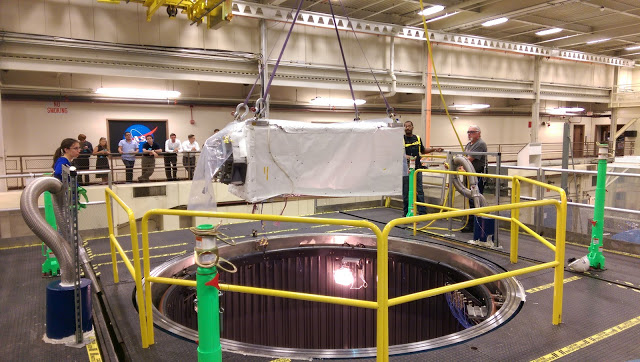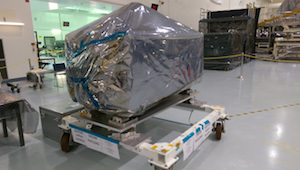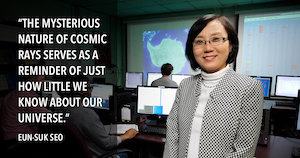Space-based Experiment Will Tackle the Mysteries of Cosmic Rays
ISS-CREAM detector to be installed on International Space Station for at least three years
On August 14, 2017, a groundbreaking University of Maryland-designed cosmic ray detector will travel to the International Space Station (ISS) aboard the SpaceX-12 Commercial Resupply Service mission. The instrument, named ISS Cosmic Ray Energetics and Mass (ISS-CREAM), is roughly the size of a refrigerator and will remain installed on the ISS’ Japanese Experiment Module for at least three years. The massive amounts of data ISS-CREAM will collect could reveal new details about the origin and diversity of cosmic rays.
 Cosmic rays are not rays at all, but highly energetic particles that zoom through space at nearly the speed of light. The particles range in size, from subatomic protons to the atomic nuclei of elements such as carbon and boron. Scientists suspect that the particles are bits of subatomic shrapnel produced by supernovae, but could also be signatures of other cataclysmic phenomena.
Cosmic rays are not rays at all, but highly energetic particles that zoom through space at nearly the speed of light. The particles range in size, from subatomic protons to the atomic nuclei of elements such as carbon and boron. Scientists suspect that the particles are bits of subatomic shrapnel produced by supernovae, but could also be signatures of other cataclysmic phenomena.
Regardless of their origin, “cosmic rays are direct samples of matter from outside our solar system—possibly from the most distant reaches of the universe,” said Eun-Suk Seo, a professor of physics at UMD and lead investigator for ISS-CREAM. Seo leads UMD’s Cosmic Ray Physics Group and has a joint appointment in the UMD Institute for Physical Science and Technology.
ISS-CREAM builds on more than a decade of work by Seo’s research group, which includes seven Long-Duration Balloon (LDB) missions in Antarctica dedicated to studying the nature of cosmic rays. Each of these LDB missions was facilitated by NASA with additional support from the National Science Foundation.
The first, known as Cosmic Ray Energetics and Mass I (CREAM I), launched in December 2004. CREAM I carried instruments to measure the energy, charge, mass and direction of incoming cosmic ray particles. The following five missions, also named CREAM and numbered II-VI, carried the same basic suite of instruments. The seventh and most recent mission took on a different name: Boron and Carbon Cosmic rays in the Upper Stratosphere (BACCUS). The flight set a record for the earliest seasonal launch in the history of NASA’s LDB program on November 28, 2016, and concluded 30 days later.
 ISS-CREAM will carry a suite of instruments very similar to its balloon-borne cousins. But unlike the balloon experiments, ISS-CREAM’s detectors will have direct, unimpeded access to incoming cosmic rays—with no atmospheric interference. Back on Earth, Seo’s team will monitor operations around the clock, taking shifts to ensure the instruments are properly calibrated and collecting the maximum amount of data.
ISS-CREAM will carry a suite of instruments very similar to its balloon-borne cousins. But unlike the balloon experiments, ISS-CREAM’s detectors will have direct, unimpeded access to incoming cosmic rays—with no atmospheric interference. Back on Earth, Seo’s team will monitor operations around the clock, taking shifts to ensure the instruments are properly calibrated and collecting the maximum amount of data.
When a cosmic ray particle reaches Earth’s atmosphere, it soon collides with another particle—most likely an atom of nitrogen or oxygen. This sets off a cascade of secondary particles that carry less energy than the original particle. The atmosphere serves as a protective filter, slowing down dangerous cosmic rays before they have a chance to damage life and property here on Earth’s surface.
This also means that Earth-bound cosmic ray detectors can only see secondary particles. By orbiting above the atmosphere, ISS-CREAM addresses this challenge and offers several other benefits compared with balloon experiments.
“To see primary particles we have to fly an instrument in space. This removes atmospheric background,” Seo explained. “Prior experiments were also limited to lower energies because of the payload size and flight duration. ISS-CREAM will extend our measurements to the highest energies possible and will allow us to increase our exposure by an order of magnitude.”
ISS-CREAM also has to withstand harsh conditions far beyond those experienced during a balloon mission.
 “ISS-CREAM has to survive a violent rocket launch. A balloon launch is very gentle by comparison,” Seo said. “ISS-CREAM also has to continue working without repairs for years, while a balloon instrument only needs to last a month or two. And any space-based experiment has to be shielded from radiation, which makes everything more expensive and the design processes more exacting.”
“ISS-CREAM has to survive a violent rocket launch. A balloon launch is very gentle by comparison,” Seo said. “ISS-CREAM also has to continue working without repairs for years, while a balloon instrument only needs to last a month or two. And any space-based experiment has to be shielded from radiation, which makes everything more expensive and the design processes more exacting.”
Cosmic ray particles could help solve one of today’s most elusive scientific puzzles: determining the nature of dark matter. According to Seo, theory suggests that dark matter particles might collide and annihilate one another, resulting in energetic particles of conventional matter that we recognize as cosmic rays. If this theory is correct, studying cosmic rays could result in promising leads in the search for dark matter.
“The mysterious nature of cosmic rays serves as a reminder of just how little we know about our universe. The discovery of cosmic rays gave birth to the field of particle physics in the early 20th century. But no human-made particle accelerator can reach the energy levels we see in cosmic rays,” Seo added. “Our team has been anxiously awaiting this launch for years. This is a very exciting time for us as well as others in the field of high-energy particle astrophysics.”
VIDEO: Cosmic Ray Energetics And Mass for the International Space Station (ISS-CREAM) is an experiment designed to provide an unprecedented look at cosmic ray particles approaching energies of 1,000 trillion electron volts (1 PeV). ISS-CREAM detects these particles when they slam into the matter making up its instruments. They can distinguish electrons, protons and atomic nuclei as massive as iron as they crash through the detector stack. Credit: NASA's Goddard Space Flight Center
###
Media Relations Contact: Matthew Wright, 301-405-9267, mewright@umd.edu
University of Maryland
College of Computer, Mathematical, and Natural Sciences
2300 Symons Hall
College Park, MD 20742
www.cmns.umd.edu
@UMDscience
About the College of Computer, Mathematical, and Natural Sciences
The College of Computer, Mathematical, and Natural Sciences at the University of Maryland educates more than 7,000 future scientific leaders in its undergraduate and graduate programs each year. The college's 10 departments and more than a dozen interdisciplinary research centers foster scientific discovery with annual sponsored research funding exceeding $150 million.







